Assignment on Advanced Financial Accounting - Doc
VerifiedAdded on 2021/01/03
|9
|2496
|468
AI Summary
Contribute Materials
Your contribution can guide someone’s learning journey. Share your
documents today.
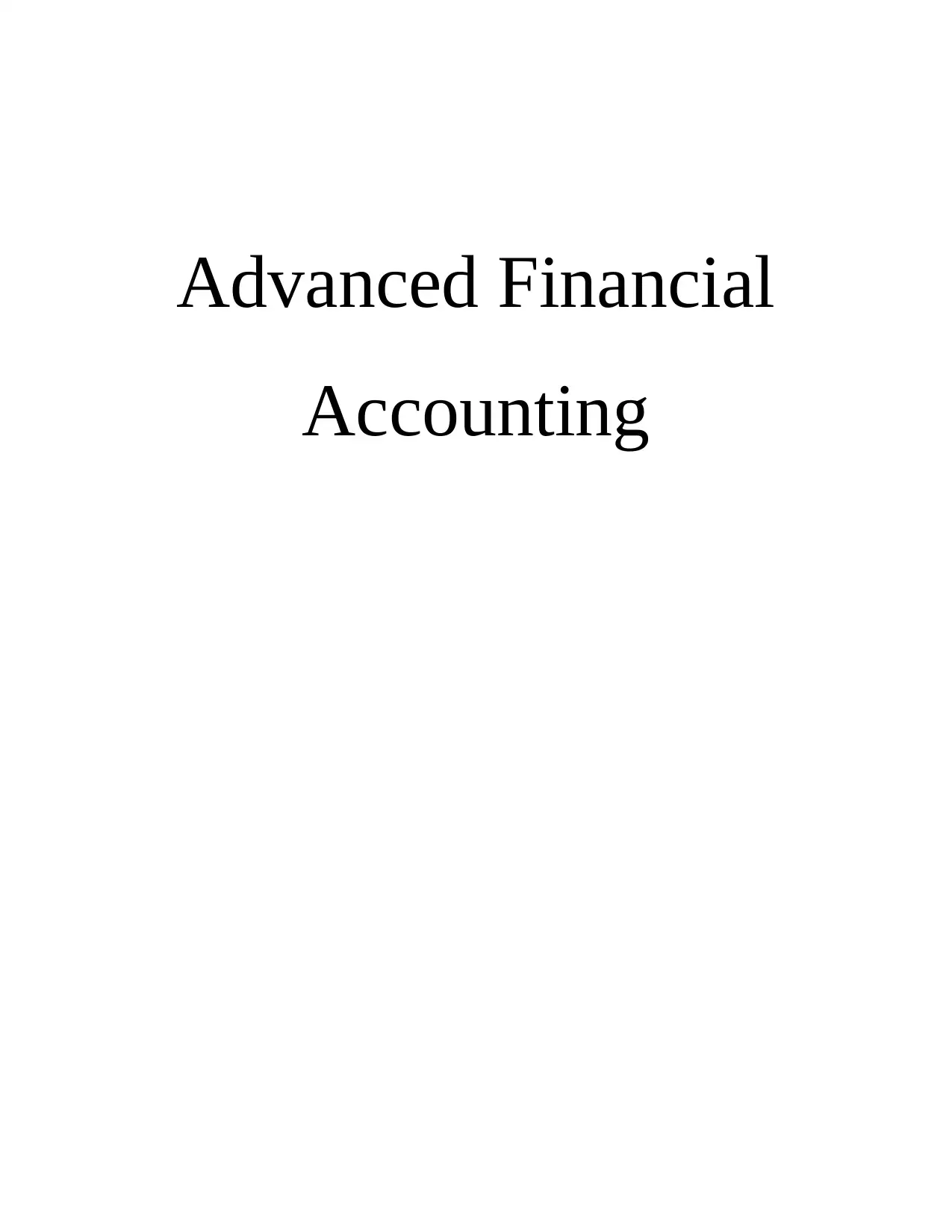
Advanced Financial
Accounting
Accounting
Secure Best Marks with AI Grader
Need help grading? Try our AI Grader for instant feedback on your assignments.
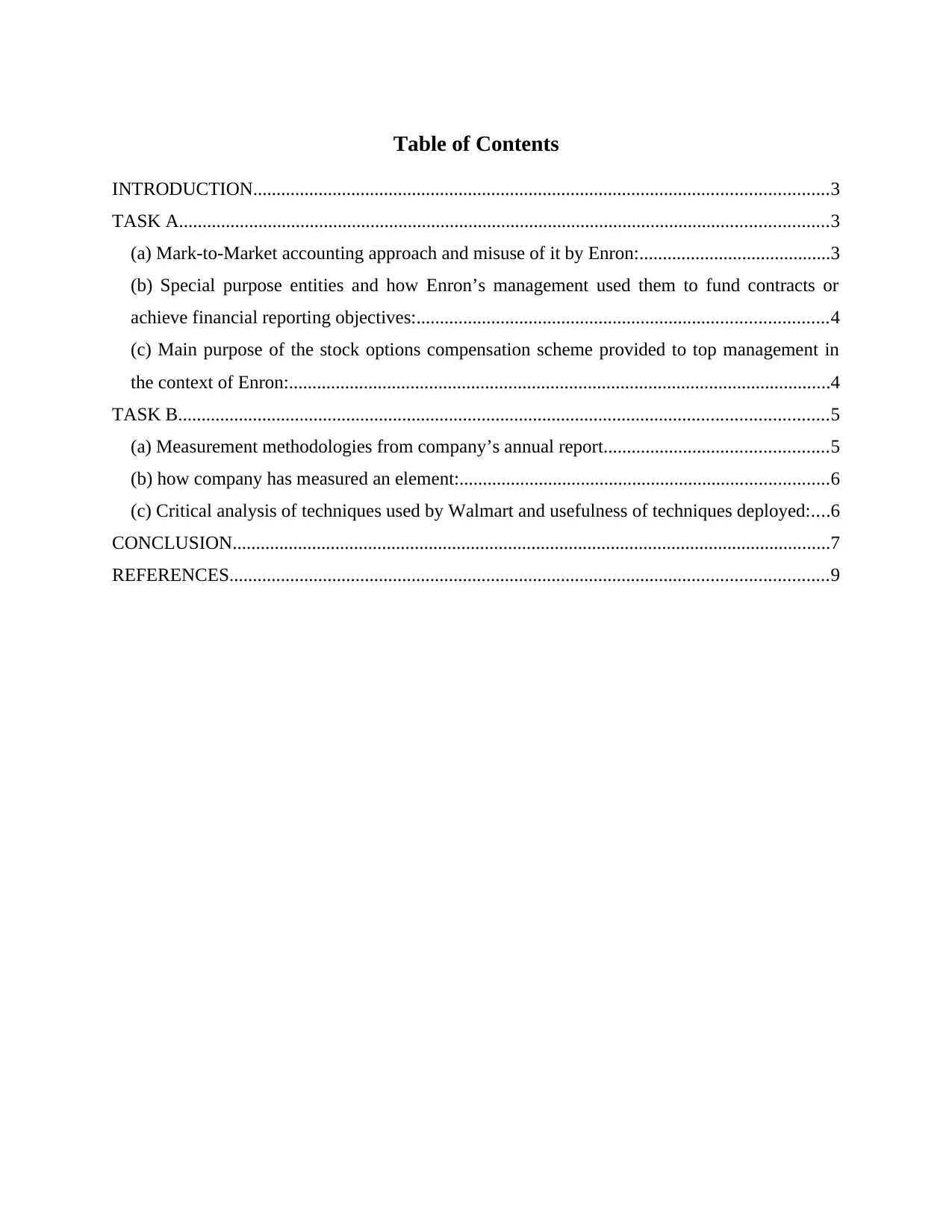
Table of Contents
INTRODUCTION...........................................................................................................................3
TASK A...........................................................................................................................................3
(a) Mark-to-Market accounting approach and misuse of it by Enron:.........................................3
(b) Special purpose entities and how Enron’s management used them to fund contracts or
achieve financial reporting objectives:........................................................................................4
(c) Main purpose of the stock options compensation scheme provided to top management in
the context of Enron:....................................................................................................................4
TASK B...........................................................................................................................................5
(a) Measurement methodologies from company’s annual report................................................5
(b) how company has measured an element:...............................................................................6
(c) Critical analysis of techniques used by Walmart and usefulness of techniques deployed:....6
CONCLUSION................................................................................................................................7
REFERENCES................................................................................................................................9
INTRODUCTION...........................................................................................................................3
TASK A...........................................................................................................................................3
(a) Mark-to-Market accounting approach and misuse of it by Enron:.........................................3
(b) Special purpose entities and how Enron’s management used them to fund contracts or
achieve financial reporting objectives:........................................................................................4
(c) Main purpose of the stock options compensation scheme provided to top management in
the context of Enron:....................................................................................................................4
TASK B...........................................................................................................................................5
(a) Measurement methodologies from company’s annual report................................................5
(b) how company has measured an element:...............................................................................6
(c) Critical analysis of techniques used by Walmart and usefulness of techniques deployed:....6
CONCLUSION................................................................................................................................7
REFERENCES................................................................................................................................9
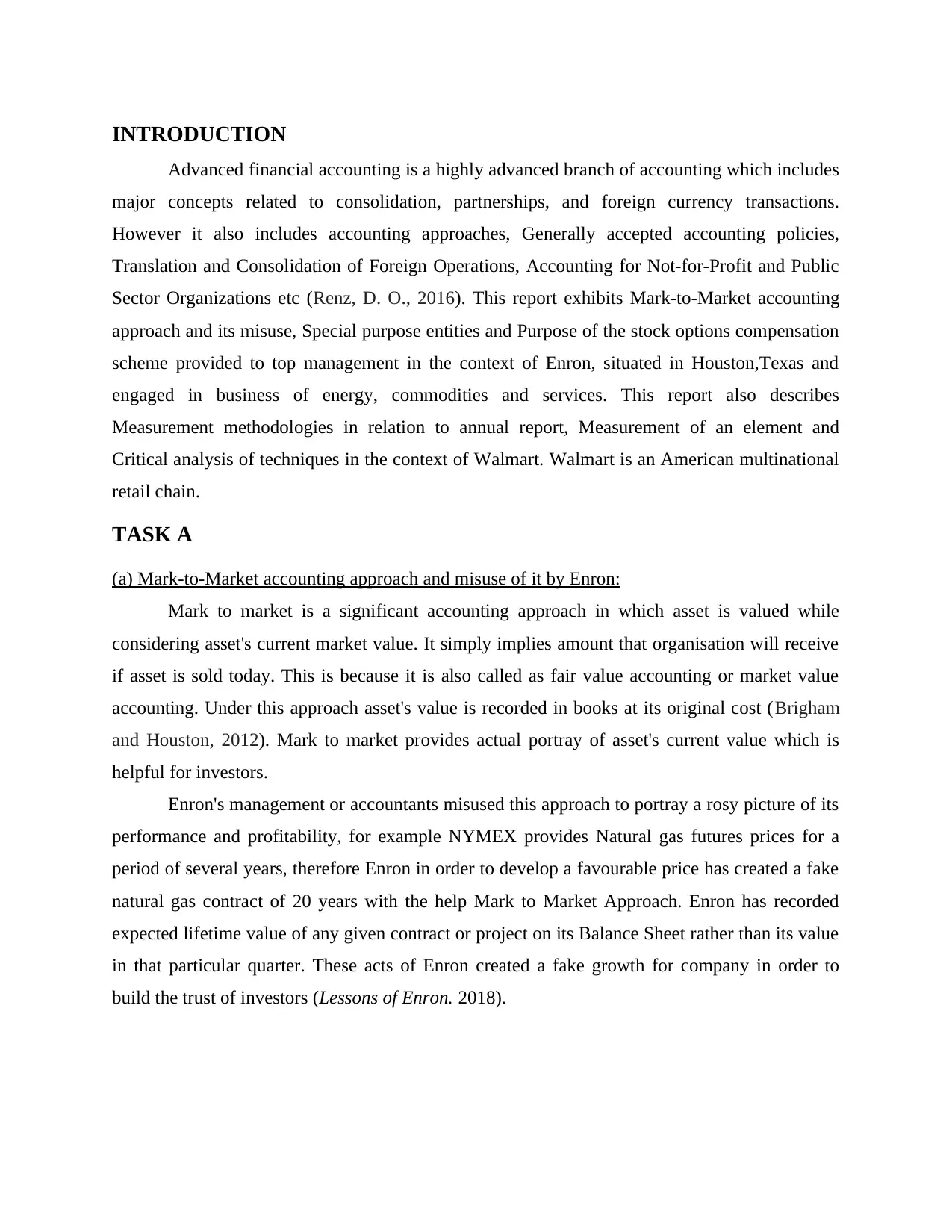
INTRODUCTION
Advanced financial accounting is a highly advanced branch of accounting which includes
major concepts related to consolidation, partnerships, and foreign currency transactions.
However it also includes accounting approaches, Generally accepted accounting policies,
Translation and Consolidation of Foreign Operations, Accounting for Not-for-Profit and Public
Sector Organizations etc (Renz, D. O., 2016). This report exhibits Mark-to-Market accounting
approach and its misuse, Special purpose entities and Purpose of the stock options compensation
scheme provided to top management in the context of Enron, situated in Houston,Texas and
engaged in business of energy, commodities and services. This report also describes
Measurement methodologies in relation to annual report, Measurement of an element and
Critical analysis of techniques in the context of Walmart. Walmart is an American multinational
retail chain.
TASK A
(a) Mark-to-Market accounting approach and misuse of it by Enron:
Mark to market is a significant accounting approach in which asset is valued while
considering asset's current market value. It simply implies amount that organisation will receive
if asset is sold today. This is because it is also called as fair value accounting or market value
accounting. Under this approach asset's value is recorded in books at its original cost (Brigham
and Houston, 2012). Mark to market provides actual portray of asset's current value which is
helpful for investors.
Enron's management or accountants misused this approach to portray a rosy picture of its
performance and profitability, for example NYMEX provides Natural gas futures prices for a
period of several years, therefore Enron in order to develop a favourable price has created a fake
natural gas contract of 20 years with the help Mark to Market Approach. Enron has recorded
expected lifetime value of any given contract or project on its Balance Sheet rather than its value
in that particular quarter. These acts of Enron created a fake growth for company in order to
build the trust of investors (Lessons of Enron. 2018).
Advanced financial accounting is a highly advanced branch of accounting which includes
major concepts related to consolidation, partnerships, and foreign currency transactions.
However it also includes accounting approaches, Generally accepted accounting policies,
Translation and Consolidation of Foreign Operations, Accounting for Not-for-Profit and Public
Sector Organizations etc (Renz, D. O., 2016). This report exhibits Mark-to-Market accounting
approach and its misuse, Special purpose entities and Purpose of the stock options compensation
scheme provided to top management in the context of Enron, situated in Houston,Texas and
engaged in business of energy, commodities and services. This report also describes
Measurement methodologies in relation to annual report, Measurement of an element and
Critical analysis of techniques in the context of Walmart. Walmart is an American multinational
retail chain.
TASK A
(a) Mark-to-Market accounting approach and misuse of it by Enron:
Mark to market is a significant accounting approach in which asset is valued while
considering asset's current market value. It simply implies amount that organisation will receive
if asset is sold today. This is because it is also called as fair value accounting or market value
accounting. Under this approach asset's value is recorded in books at its original cost (Brigham
and Houston, 2012). Mark to market provides actual portray of asset's current value which is
helpful for investors.
Enron's management or accountants misused this approach to portray a rosy picture of its
performance and profitability, for example NYMEX provides Natural gas futures prices for a
period of several years, therefore Enron in order to develop a favourable price has created a fake
natural gas contract of 20 years with the help Mark to Market Approach. Enron has recorded
expected lifetime value of any given contract or project on its Balance Sheet rather than its value
in that particular quarter. These acts of Enron created a fake growth for company in order to
build the trust of investors (Lessons of Enron. 2018).
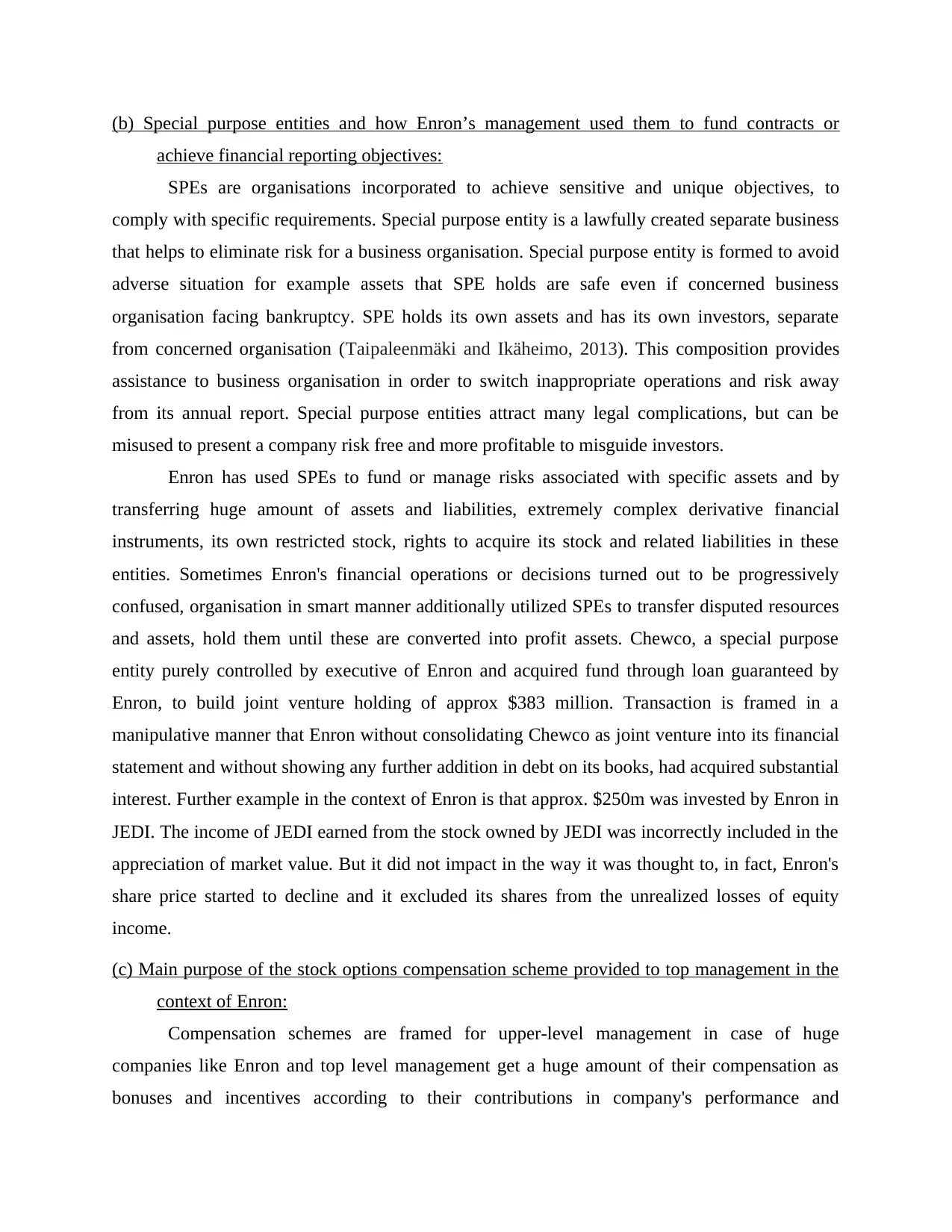
(b) Special purpose entities and how Enron’s management used them to fund contracts or
achieve financial reporting objectives:
SPEs are organisations incorporated to achieve sensitive and unique objectives, to
comply with specific requirements. Special purpose entity is a lawfully created separate business
that helps to eliminate risk for a business organisation. Special purpose entity is formed to avoid
adverse situation for example assets that SPE holds are safe even if concerned business
organisation facing bankruptcy. SPE holds its own assets and has its own investors, separate
from concerned organisation (Taipaleenmäki and Ikäheimo, 2013). This composition provides
assistance to business organisation in order to switch inappropriate operations and risk away
from its annual report. Special purpose entities attract many legal complications, but can be
misused to present a company risk free and more profitable to misguide investors.
Enron has used SPEs to fund or manage risks associated with specific assets and by
transferring huge amount of assets and liabilities, extremely complex derivative financial
instruments, its own restricted stock, rights to acquire its stock and related liabilities in these
entities. Sometimes Enron's financial operations or decisions turned out to be progressively
confused, organisation in smart manner additionally utilized SPEs to transfer disputed resources
and assets, hold them until these are converted into profit assets. Chewco, a special purpose
entity purely controlled by executive of Enron and acquired fund through loan guaranteed by
Enron, to build joint venture holding of approx $383 million. Transaction is framed in a
manipulative manner that Enron without consolidating Chewco as joint venture into its financial
statement and without showing any further addition in debt on its books, had acquired substantial
interest. Further example in the context of Enron is that approx. $250m was invested by Enron in
JEDI. The income of JEDI earned from the stock owned by JEDI was incorrectly included in the
appreciation of market value. But it did not impact in the way it was thought to, in fact, Enron's
share price started to decline and it excluded its shares from the unrealized losses of equity
income.
(c) Main purpose of the stock options compensation scheme provided to top management in the
context of Enron:
Compensation schemes are framed for upper-level management in case of huge
companies like Enron and top level management get a huge amount of their compensation as
bonuses and incentives according to their contributions in company's performance and
achieve financial reporting objectives:
SPEs are organisations incorporated to achieve sensitive and unique objectives, to
comply with specific requirements. Special purpose entity is a lawfully created separate business
that helps to eliminate risk for a business organisation. Special purpose entity is formed to avoid
adverse situation for example assets that SPE holds are safe even if concerned business
organisation facing bankruptcy. SPE holds its own assets and has its own investors, separate
from concerned organisation (Taipaleenmäki and Ikäheimo, 2013). This composition provides
assistance to business organisation in order to switch inappropriate operations and risk away
from its annual report. Special purpose entities attract many legal complications, but can be
misused to present a company risk free and more profitable to misguide investors.
Enron has used SPEs to fund or manage risks associated with specific assets and by
transferring huge amount of assets and liabilities, extremely complex derivative financial
instruments, its own restricted stock, rights to acquire its stock and related liabilities in these
entities. Sometimes Enron's financial operations or decisions turned out to be progressively
confused, organisation in smart manner additionally utilized SPEs to transfer disputed resources
and assets, hold them until these are converted into profit assets. Chewco, a special purpose
entity purely controlled by executive of Enron and acquired fund through loan guaranteed by
Enron, to build joint venture holding of approx $383 million. Transaction is framed in a
manipulative manner that Enron without consolidating Chewco as joint venture into its financial
statement and without showing any further addition in debt on its books, had acquired substantial
interest. Further example in the context of Enron is that approx. $250m was invested by Enron in
JEDI. The income of JEDI earned from the stock owned by JEDI was incorrectly included in the
appreciation of market value. But it did not impact in the way it was thought to, in fact, Enron's
share price started to decline and it excluded its shares from the unrealized losses of equity
income.
(c) Main purpose of the stock options compensation scheme provided to top management in the
context of Enron:
Compensation schemes are framed for upper-level management in case of huge
companies like Enron and top level management get a huge amount of their compensation as
bonuses and incentives according to their contributions in company's performance and
Secure Best Marks with AI Grader
Need help grading? Try our AI Grader for instant feedback on your assignments.
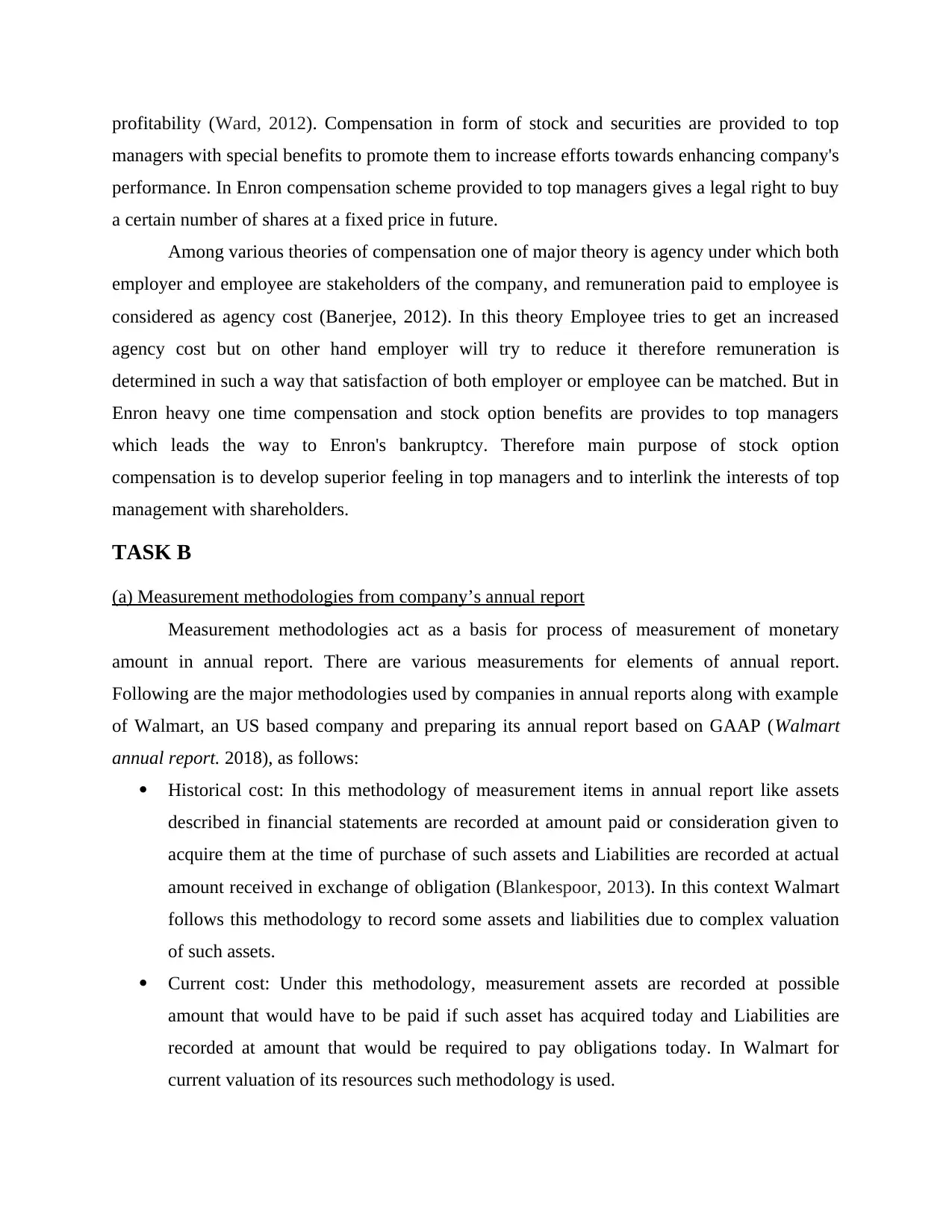
profitability (Ward, 2012). Compensation in form of stock and securities are provided to top
managers with special benefits to promote them to increase efforts towards enhancing company's
performance. In Enron compensation scheme provided to top managers gives a legal right to buy
a certain number of shares at a fixed price in future.
Among various theories of compensation one of major theory is agency under which both
employer and employee are stakeholders of the company, and remuneration paid to employee is
considered as agency cost (Banerjee, 2012). In this theory Employee tries to get an increased
agency cost but on other hand employer will try to reduce it therefore remuneration is
determined in such a way that satisfaction of both employer or employee can be matched. But in
Enron heavy one time compensation and stock option benefits are provides to top managers
which leads the way to Enron's bankruptcy. Therefore main purpose of stock option
compensation is to develop superior feeling in top managers and to interlink the interests of top
management with shareholders.
TASK B
(a) Measurement methodologies from company’s annual report
Measurement methodologies act as a basis for process of measurement of monetary
amount in annual report. There are various measurements for elements of annual report.
Following are the major methodologies used by companies in annual reports along with example
of Walmart, an US based company and preparing its annual report based on GAAP (Walmart
annual report. 2018), as follows:
Historical cost: In this methodology of measurement items in annual report like assets
described in financial statements are recorded at amount paid or consideration given to
acquire them at the time of purchase of such assets and Liabilities are recorded at actual
amount received in exchange of obligation (Blankespoor, 2013). In this context Walmart
follows this methodology to record some assets and liabilities due to complex valuation
of such assets.
Current cost: Under this methodology, measurement assets are recorded at possible
amount that would have to be paid if such asset has acquired today and Liabilities are
recorded at amount that would be required to pay obligations today. In Walmart for
current valuation of its resources such methodology is used.
managers with special benefits to promote them to increase efforts towards enhancing company's
performance. In Enron compensation scheme provided to top managers gives a legal right to buy
a certain number of shares at a fixed price in future.
Among various theories of compensation one of major theory is agency under which both
employer and employee are stakeholders of the company, and remuneration paid to employee is
considered as agency cost (Banerjee, 2012). In this theory Employee tries to get an increased
agency cost but on other hand employer will try to reduce it therefore remuneration is
determined in such a way that satisfaction of both employer or employee can be matched. But in
Enron heavy one time compensation and stock option benefits are provides to top managers
which leads the way to Enron's bankruptcy. Therefore main purpose of stock option
compensation is to develop superior feeling in top managers and to interlink the interests of top
management with shareholders.
TASK B
(a) Measurement methodologies from company’s annual report
Measurement methodologies act as a basis for process of measurement of monetary
amount in annual report. There are various measurements for elements of annual report.
Following are the major methodologies used by companies in annual reports along with example
of Walmart, an US based company and preparing its annual report based on GAAP (Walmart
annual report. 2018), as follows:
Historical cost: In this methodology of measurement items in annual report like assets
described in financial statements are recorded at amount paid or consideration given to
acquire them at the time of purchase of such assets and Liabilities are recorded at actual
amount received in exchange of obligation (Blankespoor, 2013). In this context Walmart
follows this methodology to record some assets and liabilities due to complex valuation
of such assets.
Current cost: Under this methodology, measurement assets are recorded at possible
amount that would have to be paid if such asset has acquired today and Liabilities are
recorded at amount that would be required to pay obligations today. In Walmart for
current valuation of its resources such methodology is used.
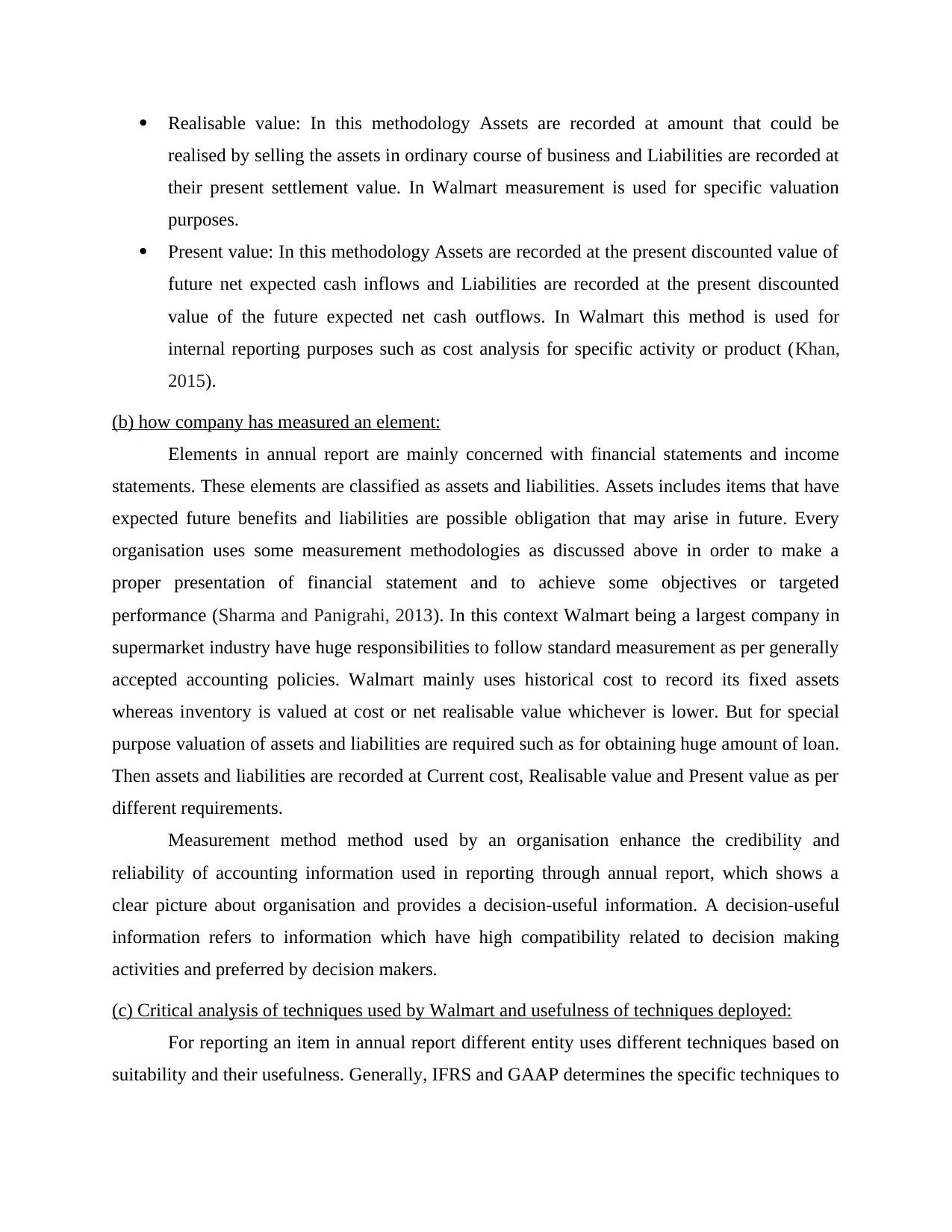
Realisable value: In this methodology Assets are recorded at amount that could be
realised by selling the assets in ordinary course of business and Liabilities are recorded at
their present settlement value. In Walmart measurement is used for specific valuation
purposes.
Present value: In this methodology Assets are recorded at the present discounted value of
future net expected cash inflows and Liabilities are recorded at the present discounted
value of the future expected net cash outflows. In Walmart this method is used for
internal reporting purposes such as cost analysis for specific activity or product (Khan,
2015).
(b) how company has measured an element:
Elements in annual report are mainly concerned with financial statements and income
statements. These elements are classified as assets and liabilities. Assets includes items that have
expected future benefits and liabilities are possible obligation that may arise in future. Every
organisation uses some measurement methodologies as discussed above in order to make a
proper presentation of financial statement and to achieve some objectives or targeted
performance (Sharma and Panigrahi, 2013). In this context Walmart being a largest company in
supermarket industry have huge responsibilities to follow standard measurement as per generally
accepted accounting policies. Walmart mainly uses historical cost to record its fixed assets
whereas inventory is valued at cost or net realisable value whichever is lower. But for special
purpose valuation of assets and liabilities are required such as for obtaining huge amount of loan.
Then assets and liabilities are recorded at Current cost, Realisable value and Present value as per
different requirements.
Measurement method method used by an organisation enhance the credibility and
reliability of accounting information used in reporting through annual report, which shows a
clear picture about organisation and provides a decision-useful information. A decision-useful
information refers to information which have high compatibility related to decision making
activities and preferred by decision makers.
(c) Critical analysis of techniques used by Walmart and usefulness of techniques deployed:
For reporting an item in annual report different entity uses different techniques based on
suitability and their usefulness. Generally, IFRS and GAAP determines the specific techniques to
realised by selling the assets in ordinary course of business and Liabilities are recorded at
their present settlement value. In Walmart measurement is used for specific valuation
purposes.
Present value: In this methodology Assets are recorded at the present discounted value of
future net expected cash inflows and Liabilities are recorded at the present discounted
value of the future expected net cash outflows. In Walmart this method is used for
internal reporting purposes such as cost analysis for specific activity or product (Khan,
2015).
(b) how company has measured an element:
Elements in annual report are mainly concerned with financial statements and income
statements. These elements are classified as assets and liabilities. Assets includes items that have
expected future benefits and liabilities are possible obligation that may arise in future. Every
organisation uses some measurement methodologies as discussed above in order to make a
proper presentation of financial statement and to achieve some objectives or targeted
performance (Sharma and Panigrahi, 2013). In this context Walmart being a largest company in
supermarket industry have huge responsibilities to follow standard measurement as per generally
accepted accounting policies. Walmart mainly uses historical cost to record its fixed assets
whereas inventory is valued at cost or net realisable value whichever is lower. But for special
purpose valuation of assets and liabilities are required such as for obtaining huge amount of loan.
Then assets and liabilities are recorded at Current cost, Realisable value and Present value as per
different requirements.
Measurement method method used by an organisation enhance the credibility and
reliability of accounting information used in reporting through annual report, which shows a
clear picture about organisation and provides a decision-useful information. A decision-useful
information refers to information which have high compatibility related to decision making
activities and preferred by decision makers.
(c) Critical analysis of techniques used by Walmart and usefulness of techniques deployed:
For reporting an item in annual report different entity uses different techniques based on
suitability and their usefulness. Generally, IFRS and GAAP determines the specific techniques to

be followed by particular entities. Following are the major techniques used by Walmart as per
annual report and their usefulness (Walmart annual report. 2018), as follows:
Walmart values inventories at the lower of cost or market by the retail inventory method
of accounting and for US segment's inventory last-in, first-out ("LIFO") method is used
by Walmart. Whereas for inventory of Walmart's International segment first-in, first-out
("FIFO") is used by company (Budding,Grossi and Tagesson, 2014). The retail inventory
method of accounting is used by Walmart to show inventory at the lower of cost or
market because permanent decease in values are recorded hand to hand with reduction of
the retail value of inventory.
Receivables are stated at their carrying values after deducting provision for doubtful
accounts as per GAAP. This treatment is used by Walmart because it helps to create
equality in accounting process and helps to disclose provisions created or used by entity
(Lambert and Sponem, 2012).
Property and equipment are recorded at cost. Profit or loss on sale or disposal of assets
are adjusted from capital reserves. Costs related major improvements that have future
probable profits are capitalized where as costs of normal repairs and maintenance are
treated as expenses. This techniques is used by Walmart to reduces the complexity and
also it provides a frameworks for classification of capital and revenue assets.
In Walmart Income tax expenses are ascertained through balance sheet method and
Deferred tax assets and liabilities are recorded as per estimated tax liability as per US
GAAP and IFRS as per their respective segments because it enables organisation to trace
out actual figure of refund, penalty if any and amount due (Ramanna, 2013).
Warlmart is using straight line method instead of effective interest method for
amortisation of goodwill. Straight line method is used by Walmart to because it helps to
maintain uniformity in amortised amount.
CONCLUSION
From above report it has been concluded that understanding of advanced financials
accounting is required in order to solve some critical issues and to identify major threats of fraud
in company. Accounting approaches are farmed to short out issues related with reporting of
financials statements but misuse of these approaches leads to significant irregularities and some
annual report and their usefulness (Walmart annual report. 2018), as follows:
Walmart values inventories at the lower of cost or market by the retail inventory method
of accounting and for US segment's inventory last-in, first-out ("LIFO") method is used
by Walmart. Whereas for inventory of Walmart's International segment first-in, first-out
("FIFO") is used by company (Budding,Grossi and Tagesson, 2014). The retail inventory
method of accounting is used by Walmart to show inventory at the lower of cost or
market because permanent decease in values are recorded hand to hand with reduction of
the retail value of inventory.
Receivables are stated at their carrying values after deducting provision for doubtful
accounts as per GAAP. This treatment is used by Walmart because it helps to create
equality in accounting process and helps to disclose provisions created or used by entity
(Lambert and Sponem, 2012).
Property and equipment are recorded at cost. Profit or loss on sale or disposal of assets
are adjusted from capital reserves. Costs related major improvements that have future
probable profits are capitalized where as costs of normal repairs and maintenance are
treated as expenses. This techniques is used by Walmart to reduces the complexity and
also it provides a frameworks for classification of capital and revenue assets.
In Walmart Income tax expenses are ascertained through balance sheet method and
Deferred tax assets and liabilities are recorded as per estimated tax liability as per US
GAAP and IFRS as per their respective segments because it enables organisation to trace
out actual figure of refund, penalty if any and amount due (Ramanna, 2013).
Warlmart is using straight line method instead of effective interest method for
amortisation of goodwill. Straight line method is used by Walmart to because it helps to
maintain uniformity in amortised amount.
CONCLUSION
From above report it has been concluded that understanding of advanced financials
accounting is required in order to solve some critical issues and to identify major threats of fraud
in company. Accounting approaches are farmed to short out issues related with reporting of
financials statements but misuse of these approaches leads to significant irregularities and some
Paraphrase This Document
Need a fresh take? Get an instant paraphrase of this document with our AI Paraphraser
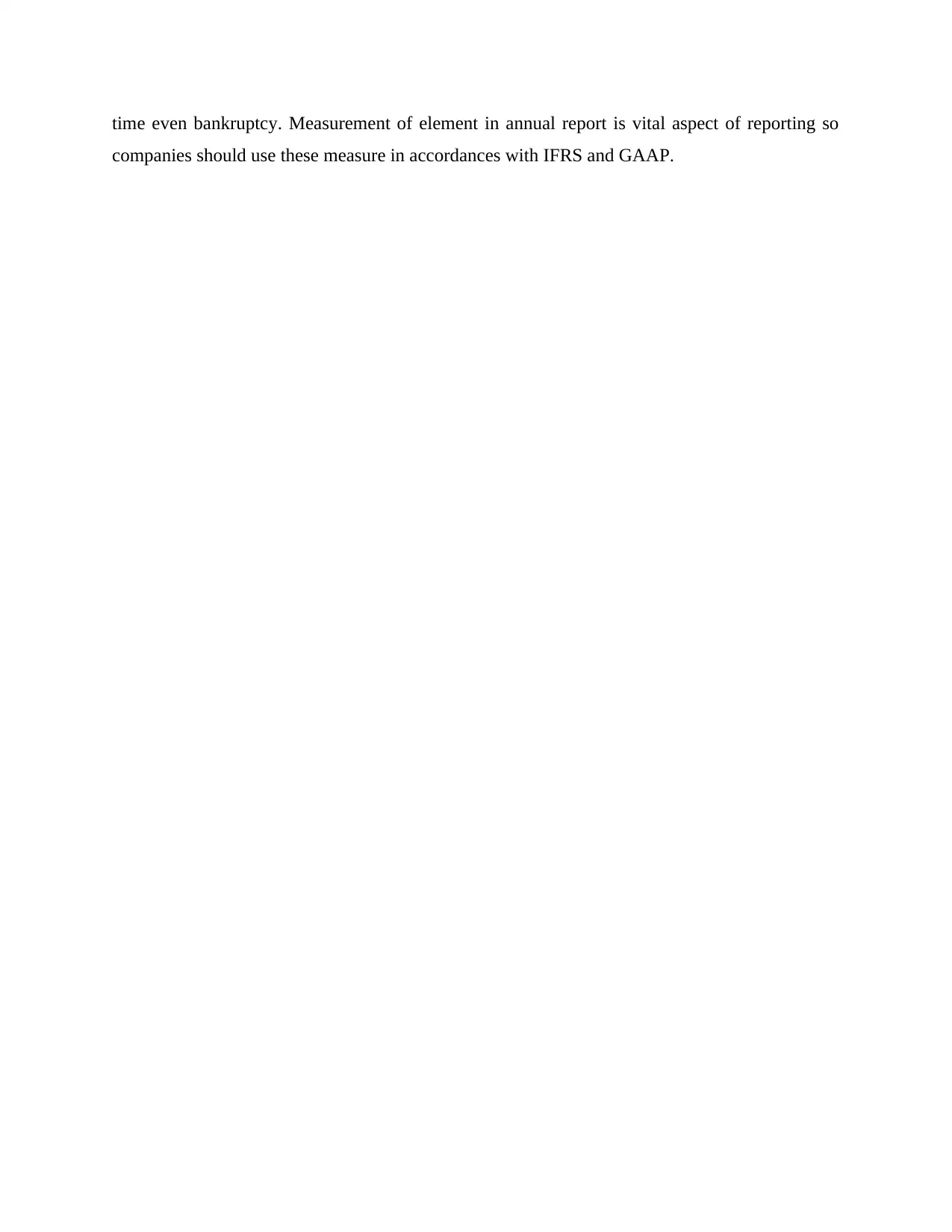
time even bankruptcy. Measurement of element in annual report is vital aspect of reporting so
companies should use these measure in accordances with IFRS and GAAP.
companies should use these measure in accordances with IFRS and GAAP.
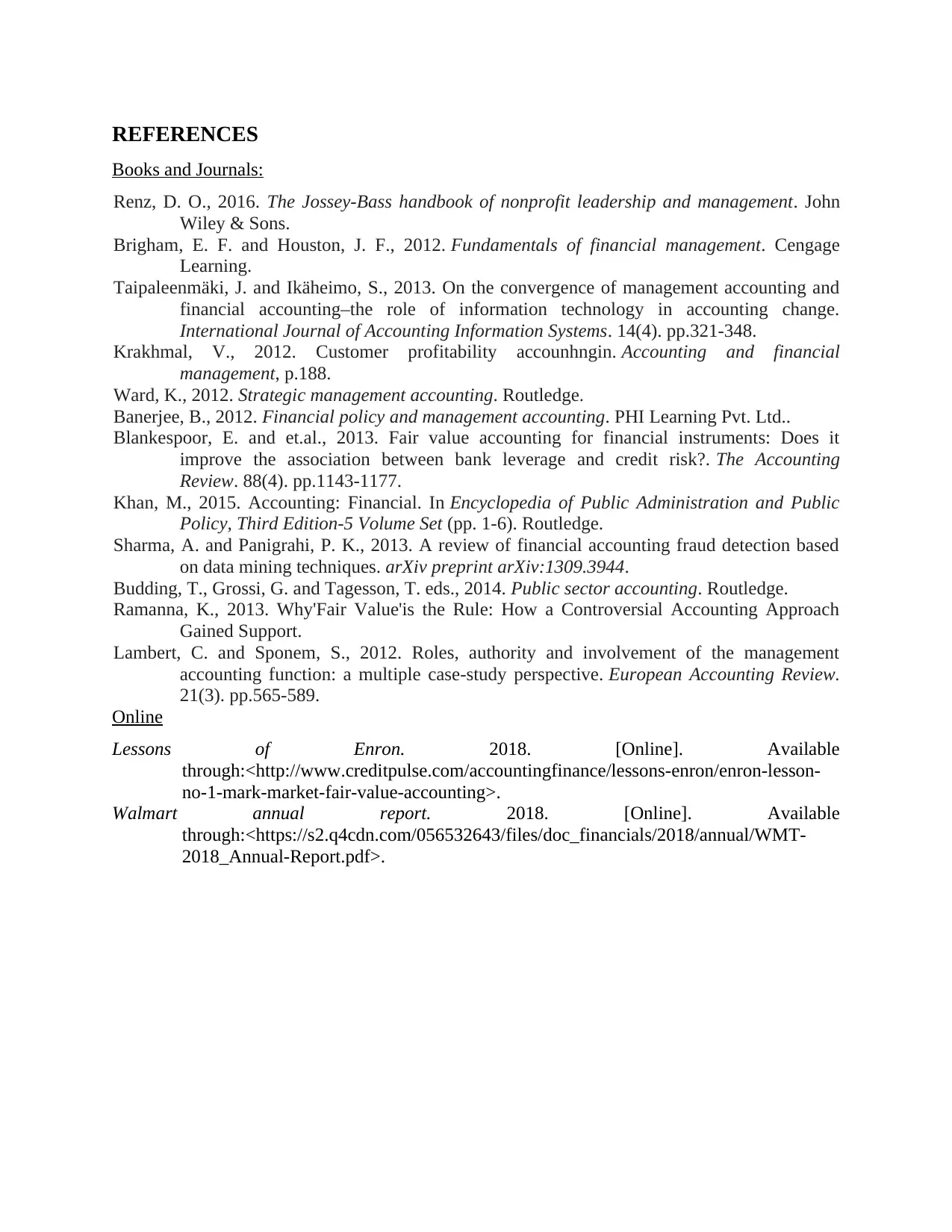
REFERENCES
Books and Journals:
Renz, D. O., 2016. The Jossey-Bass handbook of nonprofit leadership and management. John
Wiley & Sons.
Brigham, E. F. and Houston, J. F., 2012. Fundamentals of financial management. Cengage
Learning.
Taipaleenmäki, J. and Ikäheimo, S., 2013. On the convergence of management accounting and
financial accounting–the role of information technology in accounting change.
International Journal of Accounting Information Systems. 14(4). pp.321-348.
Krakhmal, V., 2012. Customer profitability accounhngin. Accounting and financial
management, p.188.
Ward, K., 2012. Strategic management accounting. Routledge.
Banerjee, B., 2012. Financial policy and management accounting. PHI Learning Pvt. Ltd..
Blankespoor, E. and et.al., 2013. Fair value accounting for financial instruments: Does it
improve the association between bank leverage and credit risk?. The Accounting
Review. 88(4). pp.1143-1177.
Khan, M., 2015. Accounting: Financial. In Encyclopedia of Public Administration and Public
Policy, Third Edition-5 Volume Set (pp. 1-6). Routledge.
Sharma, A. and Panigrahi, P. K., 2013. A review of financial accounting fraud detection based
on data mining techniques. arXiv preprint arXiv:1309.3944.
Budding, T., Grossi, G. and Tagesson, T. eds., 2014. Public sector accounting. Routledge.
Ramanna, K., 2013. Why'Fair Value'is the Rule: How a Controversial Accounting Approach
Gained Support.
Lambert, C. and Sponem, S., 2012. Roles, authority and involvement of the management
accounting function: a multiple case-study perspective. European Accounting Review.
21(3). pp.565-589.
Online
Lessons of Enron. 2018. [Online]. Available
through:<http://www.creditpulse.com/accountingfinance/lessons-enron/enron-lesson-
no-1-mark-market-fair-value-accounting>.
Walmart annual report. 2018. [Online]. Available
through:<https://s2.q4cdn.com/056532643/files/doc_financials/2018/annual/WMT-
2018_Annual-Report.pdf>.
Books and Journals:
Renz, D. O., 2016. The Jossey-Bass handbook of nonprofit leadership and management. John
Wiley & Sons.
Brigham, E. F. and Houston, J. F., 2012. Fundamentals of financial management. Cengage
Learning.
Taipaleenmäki, J. and Ikäheimo, S., 2013. On the convergence of management accounting and
financial accounting–the role of information technology in accounting change.
International Journal of Accounting Information Systems. 14(4). pp.321-348.
Krakhmal, V., 2012. Customer profitability accounhngin. Accounting and financial
management, p.188.
Ward, K., 2012. Strategic management accounting. Routledge.
Banerjee, B., 2012. Financial policy and management accounting. PHI Learning Pvt. Ltd..
Blankespoor, E. and et.al., 2013. Fair value accounting for financial instruments: Does it
improve the association between bank leverage and credit risk?. The Accounting
Review. 88(4). pp.1143-1177.
Khan, M., 2015. Accounting: Financial. In Encyclopedia of Public Administration and Public
Policy, Third Edition-5 Volume Set (pp. 1-6). Routledge.
Sharma, A. and Panigrahi, P. K., 2013. A review of financial accounting fraud detection based
on data mining techniques. arXiv preprint arXiv:1309.3944.
Budding, T., Grossi, G. and Tagesson, T. eds., 2014. Public sector accounting. Routledge.
Ramanna, K., 2013. Why'Fair Value'is the Rule: How a Controversial Accounting Approach
Gained Support.
Lambert, C. and Sponem, S., 2012. Roles, authority and involvement of the management
accounting function: a multiple case-study perspective. European Accounting Review.
21(3). pp.565-589.
Online
Lessons of Enron. 2018. [Online]. Available
through:<http://www.creditpulse.com/accountingfinance/lessons-enron/enron-lesson-
no-1-mark-market-fair-value-accounting>.
Walmart annual report. 2018. [Online]. Available
through:<https://s2.q4cdn.com/056532643/files/doc_financials/2018/annual/WMT-
2018_Annual-Report.pdf>.
1 out of 9
Related Documents
Your All-in-One AI-Powered Toolkit for Academic Success.
+13062052269
info@desklib.com
Available 24*7 on WhatsApp / Email
![[object Object]](/_next/static/media/star-bottom.7253800d.svg)
Unlock your academic potential
© 2024 | Zucol Services PVT LTD | All rights reserved.




